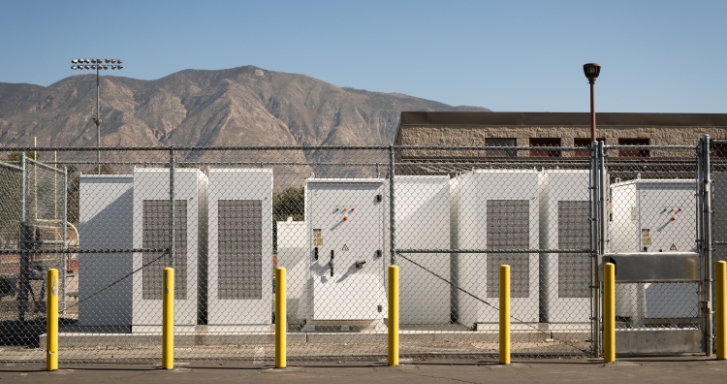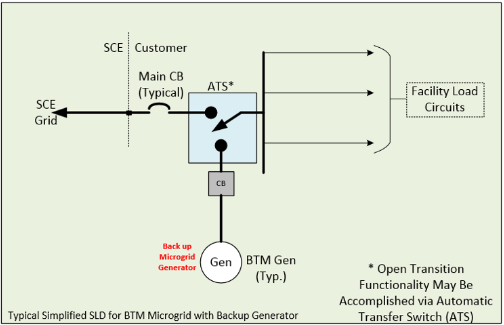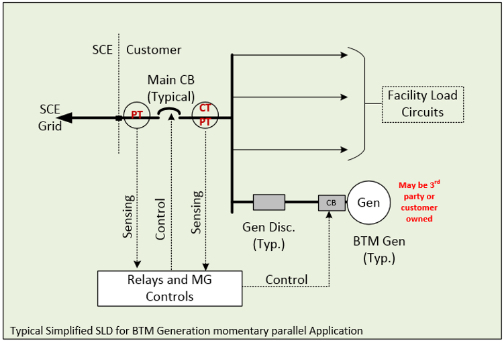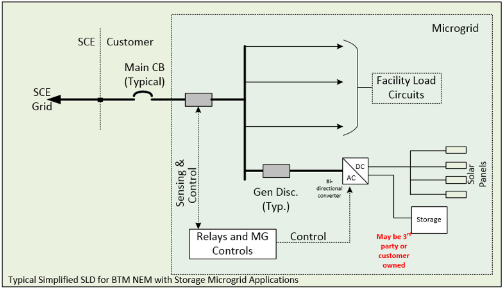This application is suited for configurations where generation is utilized onsite. This microgrid normally operates in parallel with the SCE grid and provides energy to host customer needs. As its name suggests, this microgrid does not continuously export power back to the grid. You can enhance this system with additional controls, allowing you to separate from the grid when it is unavailable (e.g., power outages) or other times you want to disconnect.
FIGURE 1: Behind-The-Meter (BTM) Microgrid Application
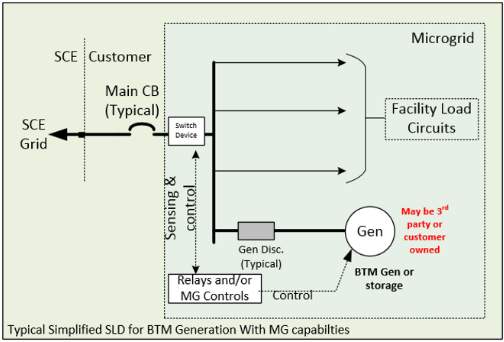
Rules:
- Must submit a Rule 21 Interconnection Application with relevant information (technical and non-technical) to SCE
- Customer (or third party and customer if generation is owned by a third party) must enter into a Rule 21 Interconnection Agreement with SCE
- Must receive a Permission to Operate (PTO) from SCE
Operating Rules:
Normal Operating Rules:
- Operates in parallel with the grid as non-export or inadvertent export in accordance with Interconnection Agreement
Microgrid Operation:
- In microgrid operation, the generation facility and customer load must separate from the SCE grid by opening a device designed for that purpose such as a breaker or other disconnecting device
- The relay and/or control systems must prevent the closing of the microgrid to the SCE grid while the SCE grid is not energized to prevent unintentional islanding
Return to Normal Operation:
- When SCE grid returns to normal, the relay and control systems must reconnect the microgrid back to the SCE grid in a manner that does not cause issue to the SCE grid by: (1) utilizing proper synchronization controls, or (2) following proper sequence of operations, such as by disconnecting the generation prior to closing the microgrid to the SCE grid (experience a temporary outage)
- Must allow the SCE grid to return to steady state normal conditions for a minimum of 5 minutes prior to closing to the SCE grid
- All relays settings, inverter settings (such as anti-islanding detection), and required limitations of operation must be in place and operational per the Interconnection Agreement requirement prior to reconnecting the microgrid to the SCE grid.
Rule 21 Interconnection Rates and Rules:
- Rule 21 non-exporting or inadvertent export provision applies
- Customer to submit Non-Export Interconnection Request to SCE. Visit www.sce.com/gridinterconnection for more information.
- SCE must issue a Permission to Operate (PTO) and execute an Interconnection Agreement prior to operation.
Cost Responsibility in Various Microgrid Ownership/Operational Models:
- Customer responsible for testing, operating and maintaining all equipment necessary to maintain a safe operation of the Generating Facility under normal operation or under a Microgrid operations
- Rule 21 Interconnection Agreements and tariffs apply
Application Checklist
- Submit an Interconnection Application with the following requirements
a. Technical information related to the generator and transformation
b. Single and Three Line Diagram
c. Plot plans identifying location of relevant electrical devices
d. Relaying Elementary and/or Control Diagrams
e. Relay settings and certified test reports
f. Inverter-based generation and storage must have UL certification and be listed in the CEC inverter listing.
g. Application fee - Executed Interconnection Agreement
- Certificate of Insurance as required per the Executed Interconnection Agreement
- As-Built Single Line Diagram
- Received Permission To Operate (PTO) from SCE
- Authority Having Jurisdiction Sign Off

